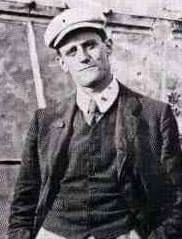James Joyce
Critique • Works • Views and quotes

Born
1882
Died
1941
Publications
Novels, stories, poems, play
Writing language
English
Literature
• Dubliners (1914)
• A Portrait of the Artist as a Young Man (1916)
• Ulysses (1922)
• Finnegans Wake (1939)
Novels
• A Portrait of the Artist as a Young Man (1916)
• Ulysses (1922)
• Finnegans Wake (1939)
Stories
• "Araby" (1914)
• "Two Gallants" (1914)
• "The Dead" (1914)
Story Collections
• Dubliners (1914)
Irish Literature
• Dubliners (1914)
• A Portrait of the Artist as a Young Man (1916)
• Exiles (1918)
• Ulysses (1922)
• Finnegans Wake (1939)
Down the stream to oblivion
Scholarly opinion is that James Joyce revolutionized the novel in the twentieth century by abandoning conventional narrative for stream of consciousness and unprecedented play of language. It holds Joyce's Ulysses as the peak of literary achievement in this regard, perhaps rivalled only by his Finnegans Wake. It also holds his earlier works are interesting in that they show the development leading to his two masterpieces.
I hold an almost exactly opposite view.
Joyce's earlier work is his best in my opinion and he made a major mistake by focusing on stream of consciousness and atomic word play to the exclusion of narrative. Only a few parts of Ulysses—such as the bawdy and moving soliloquy by Molly Bloom—show how effectively Joyce really could write. And his long-in-the-making "masterpiece" of Finnegans Wake is not only overly long-in-the-reading but mostly unreadable.
There is some evidence also that near the end of his life Joyce feared he had gone wrong in this way. In any case, his most extreme experiments in narrative mode have had little influence among writers who followed him. Passages here and there adapt his techniques and the occasional work takes a wholly stream-of-consciousness approach—though even then usually in a less difficult fashion, presenting characters' interior monologues in colloquial language. It could be argued moreover that these efforts might have more directly developed as they did without Joyce's massive tomes pointing the convoluted way.
The hero in his own mind
Joyce was born and raised in Dublin and that city, as well as Ireland in general, plays a big part in his fiction. He moved to Europe as a young man and lived mainly in Zurich and Paris with his lover (eventually his wife) Nora Barnacle and his children. He considered himself an exile from Ireland with which he had a love-hate relationship.
His earliest published literary works were poems later collected as Chamber Music and stories collected as Dubliners (1914). The poems are undistinguished (though they did receive some admiring reviews at the time) but the naturalistic stories—especially the moving final story, "The Dead"—are accepted as small masterpieces. His intended Dublin publisher destroyed its copies of Dubliners when Joyce refused to remove allegedly disrespectful comments about the royal family, but the book was eventually published by a London firm.
 For many years before this, Joyce had also been working on an autobiographical
novel he called Stephen Hero about an Irish youth in conflict
with church and country. It ran to nearly a thousand pages. After it
was rejected by several publishers, Joyce threw the manuscript in the
fire. Joyce began the story again in a more compact style with everything
taking place from Stephen's interior point of view and this became his
first published novel,
A Portrait of the Artist
as Young Man (1916). Portions of Stephen Hero which were
rescued from the fire by his sister Eileen, according to Joycean legend,
were published in 1944 after Joyce's death.
For many years before this, Joyce had also been working on an autobiographical
novel he called Stephen Hero about an Irish youth in conflict
with church and country. It ran to nearly a thousand pages. After it
was rejected by several publishers, Joyce threw the manuscript in the
fire. Joyce began the story again in a more compact style with everything
taking place from Stephen's interior point of view and this became his
first published novel,
A Portrait of the Artist
as Young Man (1916). Portions of Stephen Hero which were
rescued from the fire by his sister Eileen, according to Joycean legend,
were published in 1944 after Joyce's death.
Ulysses (1922), took stream-of consciousness further, with the story taking place entirely within the minds of its main characters—namely Stephen Dedalus from Portrait of the Artist as a Young Man, advertising agent Leopold Bloom, and Bloom's promiscuous wife Molly—as they go their ways through Dublin during a single day. The novel was impounded and burned in several countries for the lewd thoughts it revealed in its characters' (especially Molly's) minds.
From then until his last year, Joyce worked on a massive book referred to as Work in Progress when segments were published in literary magazines. It was finally published in 1939 as Finnegans Wake. His last book, it has been widely admired by a few academics while remaining unread by anyone else, since narrative and character—even complete words, sentences and paragraphs—are eschewed in favour of multilingual word play.
Contrary to what you might expect, most of Joyce's literary works have been interpreted in films, with John Huston's The Dead in 1987, Joseph Strick's Portrait of the Artist in 1977, Strick's Ulysses in 1967 (plus a new version called Bl,.m in 2003), and even Finnegans Wake in 1967.
— Eric
Critique • Works • Views and quotes

